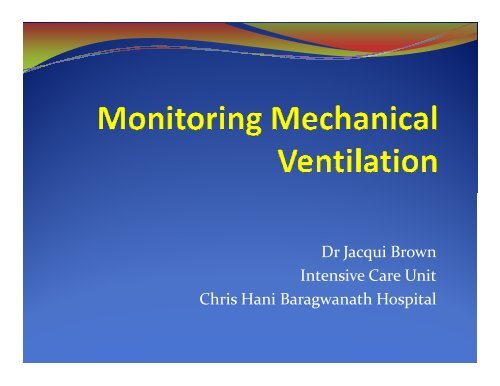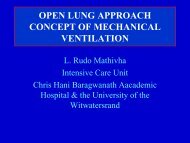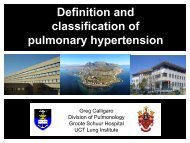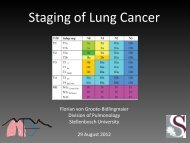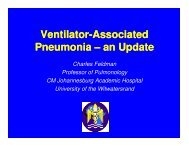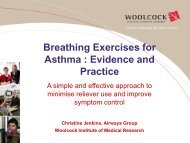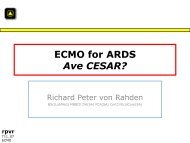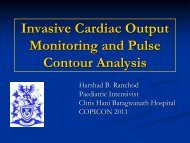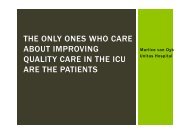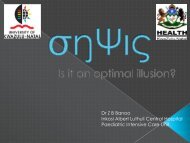Monitoring Mechanical Ventilation
Monitoring Mechanical Ventilation
Monitoring Mechanical Ventilation
- No tags were found...
Create successful ePaper yourself
Turn your PDF publications into a flip-book with our unique Google optimized e-Paper software.
Dr Jacqui Brown<br />
Intensive Care Unit<br />
Chris Hani Baragwanath Hospital
Contents<br />
Introduction<br />
Gas exchange<br />
ABG<br />
Oxymetry<br />
Capnography<br />
Respiratory mechanics<br />
Airway Graphics<br />
Other<br />
CXR
Introduction<br />
<strong>Monitoring</strong> : derived from Latin word monere<br />
meaning ‘to warn’<br />
In the past : manual measurements by nursing staff,<br />
and organs other that the lung e.g. ECG<br />
Goals of continuous monitoring :<br />
follow real time specific physiological values that change<br />
rapidly – alerts for adverse events<br />
Aid in diagnosis<br />
Enables assessment of therapeutic intervention
Introduction<br />
Ideal monitoring systems:<br />
Must have the potential to alter/influence the<br />
management of the patient<br />
Easy to use and interpret<br />
Technically accurate, both specific and sensitive<br />
Safe<br />
Not interfere with patient care<br />
Inexpensive
Introduction<br />
Respiratory function:<br />
<strong>Monitoring</strong> gas exchange<br />
Oxygenation<br />
<strong>Ventilation</strong><br />
<strong>Monitoring</strong> lung and chest wall mechanics<br />
Complience<br />
Resistance<br />
Pressure
Gas Exchange<br />
Aim of mechanical ventilation:<br />
Maintain gas exchange to keep body in relative<br />
homeostasis<br />
<br />
<br />
Deliver sufficient oxygen to body<br />
Eliminate CO2
Gas Exchange<br />
The clinical significance of hypoxia/hypercapnia depends on<br />
Chronicity<br />
Compensatory mechanisms<br />
Tolerance of vital organs e.g brain and heart<br />
Degree of oxygenation depends on patient and condition<br />
Not all patients require full O2 saturation or normal CO2<br />
May not achieve “Normal” values
Gas Exchange<br />
Methods to assess Oxygenation<br />
1. Naked eye – poor<br />
2. ABG – PaO2 and Sat<br />
3. Pulse oximetry<br />
Methods to assess ventilation (CO2)<br />
1. ABG – PaCO2<br />
2. Capnography
Arterial Blood Gas<br />
Widely used<br />
Advantages:<br />
1. Direct measurement of PaO2 and PaCO2<br />
2. Also gives values for acid-base status and electrolytes<br />
Disadvantage:<br />
1. Not specific or sensitive<br />
2. Calculates saturation<br />
3. Requires invasive procedure - safety, accuracy<br />
4. Intermittent sampling – miss events
Arterial Blood Gas<br />
Need to know normal values.<br />
Factors influencing values:<br />
1. Age<br />
1. PaCO2 remains relatively constant<br />
2. PaO2 decreases with age<br />
2. Altitude<br />
3. Natural variations<br />
4. Sampling techniques
Arterial Blood Gas<br />
Other information that can be obtained and calculated using<br />
ABG.<br />
Efficacy of oxygen exchange<br />
1. Alveolar gas equation<br />
<br />
<br />
<br />
PAO2 = PIO2 – (PaCO2/R)<br />
N≈ 100mmHg at sea level , and 75mmHg in JHB<br />
AaDO2 = PAO2 – PaO2<br />
1. N≈ 10mmHG in room air<br />
2. Oxygenation index PaO2/(FiO2 X Paw)<br />
3. PaO2/FiO2
Arterial Blood Gas<br />
<strong>Ventilation</strong><br />
PaCO2 is directly measured in blood.<br />
PaCO2 is a measure of ventilation – CO2 elimination<br />
Increaesed PaCO2<br />
Airway obstruction and bronchospasm.<br />
Hypoventilation<br />
Increased metabolism
Gas Exchange - Oxymetry<br />
Initially used in WW2 for pilots.<br />
Determines O2 saturation by absorption<br />
spectrophotometry.<br />
Uses the difference in the absorption spectra of oxyHb<br />
and reduced Hb.<br />
Absorption of light by capillary blood is constant.<br />
Pulsatile arterial blood – light absorption is variable, so<br />
saturation can be calculated
Gas Exchange - Oxymetry<br />
Monitor advantages:<br />
1. Inexpensive<br />
2. Accurate<br />
1. - not accurate at sats below 80%<br />
3. Direct measurement<br />
4. Continuous<br />
5. Non-invasive<br />
6. With arterial wave tracing - can see stroke volume<br />
variation
Pulsoximetry
Gas Exchange - Oxymetry<br />
Limitations<br />
1. Underestimates with decreased perfusion<br />
2. Other forms of Hb absorb at different wavelengths<br />
3. Jaundice can cause false low readings<br />
4. CarboxyHb cause false high readings<br />
5. Chaotic pulse waves (AF) can give unpredictable<br />
readings
O2 dissociation curve
Gas Exchange - Capnography<br />
Analysis of expired CO2 against time.<br />
Provides information about respiratory rate and rhythm.<br />
Gives information about ETT placement, including<br />
obstruction, disconnection and kinking<br />
In healthy subjects, when ventilation and perfusion are<br />
equally distributed end-tidal CO2 approximates PaCO2<br />
Can be used to determine dead space, cardiac output and<br />
pulmonary embolism<br />
Placed between ETT and expiratory limb of vent tubing
Gas Exchange - Capnography<br />
Can be used to determine ‘best PEEP’<br />
The arterial to end-tidal CO2 is minimized when<br />
perfused alveoli are recruited maximally.<br />
The PaCO2 – P ET CO2 difference could help identify<br />
‘best PEEP
Gas Exchange - Capnography<br />
4 phases<br />
Phase I-III : exhalation<br />
Phase IV : Inhalation<br />
Phase I : Anatomical dead space. CO2 = O<br />
Phase II : Mixture of dead space and alveolar ventilation<br />
= abrupt rise in CO2<br />
Phase III : Plateau = pure alveolar ventilation<br />
Phase IV : Inhalation = rapid fall in CO2
Respiratory Mechanics<br />
IPPV is non-physiological<br />
Need to monitor the mechanics of mechanical<br />
ventilation<br />
How it affects chest wall and lungs-<br />
Complience, resistence, airway pressures and volumes<br />
Physical examination<br />
Airway graphics
Airway Graphics<br />
Rapidly and continuously identifies the presence or<br />
absence of respiratory pathophysiology and ventilator<br />
performance.<br />
Adverse ventilator effects can be identified, diagnosed<br />
and corrected
Measured<br />
Parameters<br />
Flow<br />
Pressure<br />
Time<br />
Calculated<br />
Parameters<br />
Volume<br />
Compliance<br />
Resistance
Waves<br />
Most common wave forms:<br />
Flow : Time<br />
Airway Pressure : Time<br />
Volume : Time<br />
Time always on x-axis
Loops<br />
Most common loops<br />
Flow : Volume<br />
Pressure : Volume
Waves
Pressure-Time wave<br />
20<br />
Volume <strong>Ventilation</strong><br />
Pressure <strong>Ventilation</strong><br />
P<br />
Paw<br />
cmH 2 O<br />
Inspiration Expiration<br />
1 2 3 4 5 6<br />
S
Flow / Time Waveform<br />
120<br />
Inspiration<br />
Volume Control Breath<br />
Square Wave (Constant Flow)<br />
Flow Pattern<br />
V. .<br />
L/min<br />
1 2 3 4 5 6<br />
S<br />
Expiration<br />
120
Pressure Control – Flow/Time
20<br />
Volume Control<br />
Breath<br />
Pressure Control<br />
Breath<br />
P<br />
Paw<br />
cmH 2 O<br />
Inspiratory<br />
Time<br />
1 2 3 4 5<br />
S<br />
V .
Volume Time wave<br />
700<br />
I-Time<br />
E-Time<br />
A<br />
B<br />
V T<br />
mL<br />
1 2 3 4 5 6<br />
S<br />
A = inspiratory volume<br />
B = expiratory volume
Pressure Control<br />
Pressure<br />
PC above PEEP<br />
Time<br />
PEEP<br />
Flow<br />
Time<br />
Volume<br />
Time
Volume control<br />
50 cmH 2 O<br />
T<br />
Pressure<br />
70 l/min<br />
Flow<br />
-70<br />
700 ml<br />
Volume
Loops
Pressure /Volume Loop<br />
Patient-Triggered Spontaneous Breath<br />
V T<br />
LITERS<br />
Clockwise<br />
0.6<br />
0.4<br />
0.2<br />
Paw<br />
Inspiration<br />
Expiration<br />
cmH 2 O<br />
-60<br />
40<br />
20<br />
0 20 40 60
Pressure /Volume Loop<br />
Time-Triggered Mandatory Breath<br />
V T<br />
LITERS<br />
0.6<br />
Counterclockwise<br />
0.4<br />
Expiration<br />
0.2<br />
Paw<br />
Inspiration<br />
cmH 2 O<br />
-60<br />
40<br />
20<br />
0 20 40 60
Flow / Volume Loop<br />
Volume Control Mandatory Breath<br />
.<br />
V<br />
L/min<br />
Inspiration<br />
Expiration<br />
Volume Control<br />
Volume<br />
Breath<br />
Control Breath<br />
Square Wave (Constant<br />
Square<br />
Flow)<br />
Wave<br />
Flow Pattern<br />
(Constant Flow)<br />
Flow Pattern<br />
V T<br />
Liters<br />
Tidal Volume<br />
Peak Inspiratory Flow<br />
Peak Expiratory Flow
Flow / Volume Loop<br />
Pressure Control Mandatory Breath<br />
.<br />
V<br />
L/min<br />
Inspiration<br />
Expiration<br />
Volume Control<br />
Pressure<br />
Breath<br />
Control Breath<br />
Square Wave (Constant<br />
Decelerating<br />
Flow)<br />
Flow Pattern<br />
Flow Pattern<br />
V T<br />
Liters<br />
Tidal Volume<br />
Peak Inspiratory Flow<br />
Peak Expiratory Flow
Clinical Significance<br />
Is the trace normal<br />
What looks abnormal<br />
What would explain the abnormality<br />
Does it correlate with clinical findings
Air Stacking and autoPEEP<br />
Exhalation does not return to zero and overlaps with next inspiration.<br />
1.2<br />
A<br />
V T<br />
Liters<br />
-0.4<br />
1 2 3 4 5 6<br />
SEC
Optimal PEEP<br />
PEEP below critical<br />
opening pressure
Optimal PEEP
Overdistention<br />
A = inspiratory pressure<br />
B = upper inflection point<br />
C = no lower inflection point<br />
(adequate alveolar recruitment<br />
V T<br />
LITERS<br />
0.6<br />
0.4<br />
A<br />
0.2<br />
B<br />
C<br />
Paw<br />
cmH 2 O<br />
-60<br />
-40<br />
-20<br />
0 20 40 60
Overdistention
Decreased compliance<br />
A higher pressure for the same volume indicates a drop in compliance.<br />
Pressure Volume Loop<br />
V T<br />
LITERS<br />
0.6<br />
0.4<br />
0.2<br />
Paw<br />
cmH 2 O<br />
-60<br />
40<br />
20<br />
0 20 40 60
Secretions<br />
SAWTOOTH PATTERN<br />
NEEDS SUCTIONING
Conclusion<br />
Airway graphic analysis provides continuous,<br />
noninvasive information which alerts<br />
clinicians to unexpected changes in patients<br />
ventilatory status and aids in the optimal<br />
management of mechanical ventilation<br />
The basic principles of physical<br />
examination should still be the first line<br />
approach of monitoring the critically ill.
Conclusion<br />
Instant data allows for:<br />
•Quicker recognition / response to<br />
changes in patient status<br />
• number of invasive procedures<br />
• number of exposures to radiation<br />
• expense


